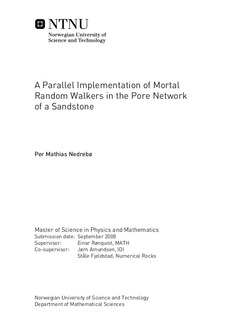| dc.contributor.advisor | Rønquist, Einar | nb_NO |
| dc.contributor.advisor | Amundsen, Jørn | nb_NO |
| dc.contributor.advisor | Fjeldstad, Ståle | nb_NO |
| dc.contributor.author | Nedrebø, Per Mathias | nb_NO |
| dc.date.accessioned | 2014-12-19T13:58:02Z | |
| dc.date.available | 2014-12-19T13:58:02Z | |
| dc.date.created | 2010-09-04 | nb_NO |
| dc.date.issued | 2008 | nb_NO |
| dc.identifier | 348725 | nb_NO |
| dc.identifier | ntnudaim:4259 | nb_NO |
| dc.identifier.uri | http://hdl.handle.net/11250/258469 | |
| dc.description.abstract | Simulations of the nuclear magnetic resonance relaxation method is an important part of a digital laboratory developed by Numerical Rocks. The laboratory is used to model petrophysical properties and simulating fluid flow in the pore scale of reservoir rocks. The nuclear magnetic resonance relaxation method can be simulated on a computer using a method involving random walkers. This computer simulation can be parallelized to reduce computational time. The aim of this study has been to examine how overlapping boundaries affects speed-up and communication in a parallel simulation of random walkers. Several parallel algorithms have been proposed and implemented. It was found that an overlapping partitioning of the problem is recommended, and that communication decreases exponentially with increasing overlap. However, increased overlap resulted only in a small negative impact on memory usage and speed-up. | nb_NO |
| dc.language | eng | nb_NO |
| dc.publisher | Institutt for matematiske fag | nb_NO |
| dc.subject | ntnudaim | no_NO |
| dc.subject | SIF3 fysikk og matematikk | no_NO |
| dc.subject | Industriell matematikk | no_NO |
| dc.title | A Parallel Implementation of Mortal Random Walkers in the Pore Network of a Sandstone | nb_NO |
| dc.type | Master thesis | nb_NO |
| dc.source.pagenumber | 71 | nb_NO |
| dc.contributor.department | Norges teknisk-naturvitenskapelige universitet, Fakultet for informasjonsteknologi, matematikk og elektroteknikk, Institutt for matematiske fag | nb_NO |

